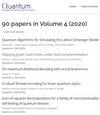Handbook for Efficiently Quantifying Robustness of Magic
IF 5.1
2区 物理与天体物理
Q1 PHYSICS, MULTIDISCIPLINARY
引用次数: 0
Abstract
The nonstabilizerness, or magic, is an essential quantum resource to perform universal quantum computation. Robustness of magic (RoM) in particular characterizes the degree of usefulness of a given quantum state for non-Clifford operation. While the mathematical formalism of RoM can be given in a concise manner, it is extremely challenging to determine the RoM in practice, since it involves superexponentially many pure stabilizer states. In this work, we present efficient novel algorithms to compute the RoM. The crucial technique is a subroutine that achieves the remarkable features in calculation of overlaps between pure stabilizer states: (i) the time complexity per each stabilizer is reduced exponentially, (ii) the space complexity is reduced superexponentially. Based on this subroutine, we present algorithms to compute the RoM for arbitrary states up to $n=7$ qubits on a laptop, while brute-force methods require a memory size of 86 TiB. As a byproduct, the proposed subroutine allows us to simulate the stabilizer fidelity up to $n=8$ qubits, for which naive methods require memory size of 86 PiB so that any state-of-the-art classical computer cannot execute the computation. We further propose novel algorithms that utilize the preknowledge on the structure of target quantum state such as the permutation symmetry of disentanglement, and numerically demonstrate our state-of-the-art results for copies of magic states and partially disentangled quantum states. The series of algorithms constitute a comprehensive “handbook'' to scale up the computation of the RoM, and we envision that the proposed technique applies to the computation of other quantum resource measures as well.高效量化魔术鲁棒性手册
不稳定性或魔力是执行通用量子计算的重要量子资源。魔力的鲁棒性(RoM)特别表征了给定量子态在非克里福德操作中的有用程度。虽然 RoM 的数学形式可以简明地给出,但在实践中确定 RoM 却极具挑战性,因为它涉及超指数的许多纯稳定态。在这项工作中,我们提出了计算 RoM 的高效新算法。其中的关键技术是一个子程序,它在计算纯稳定器状态之间的重叠时实现了以下显著特点:(i) 每个稳定器的时间复杂度呈指数级降低,(ii) 空间复杂度呈超指数级降低。基于这个子程序,我们提出了在笔记本电脑上计算高达 $n=7$ 量子比特的任意状态的 RoM 算法,而蛮力方法需要 86 TiB 的内存大小。作为副产品,我们提出的子程序允许我们模拟高达 $n=8$ 量子位的稳定器保真度,而对于这种稳定器保真度,天真方法需要 86 PiB 的内存容量,因此任何最先进的经典计算机都无法执行计算。我们进一步提出了利用目标量子态结构预知(如解纠缠的置换对称性)的新算法,并在魔态副本和部分解纠缠量子态上用数值证明了我们最先进的结果。这一系列算法构成了一本扩展 RoM 计算的综合 "手册",我们设想所提出的技术也适用于其他量子资源度量的计算。
本文章由计算机程序翻译,如有差异,请以英文原文为准。
求助全文
约1分钟内获得全文
求助全文
来源期刊

Quantum
Physics and Astronomy-Physics and Astronomy (miscellaneous)
CiteScore
9.20
自引率
10.90%
发文量
241
审稿时长
16 weeks
期刊介绍:
Quantum is an open-access peer-reviewed journal for quantum science and related fields. Quantum is non-profit and community-run: an effort by researchers and for researchers to make science more open and publishing more transparent and efficient.
 求助内容:
求助内容: 应助结果提醒方式:
应助结果提醒方式:


